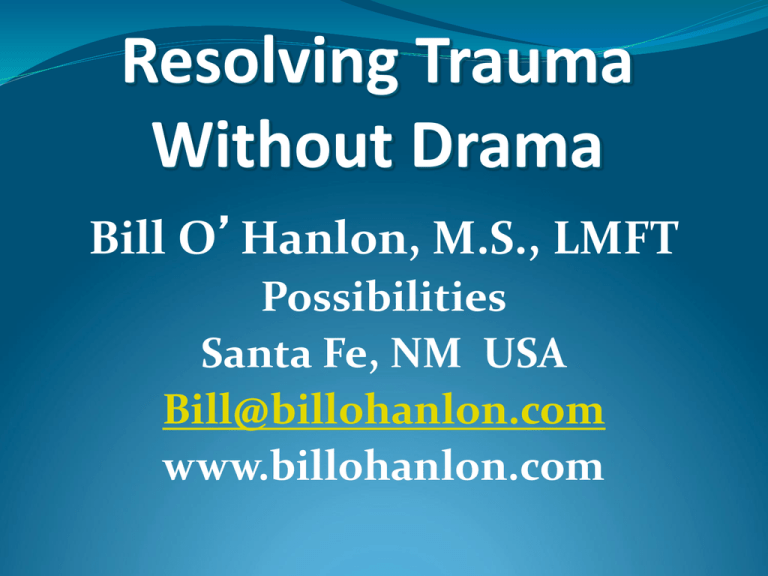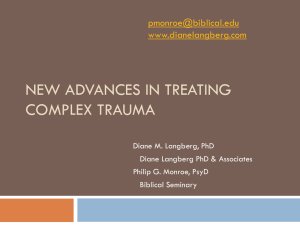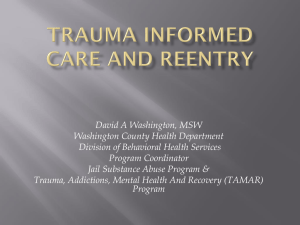
Resolving Trauma
Without Drama
Bill O’Hanlon, M.S., LMFT
Possibilities
Santa Fe, NM USA
Bill@billohanlon.com
www.billohanlon.com
Good News about PTSD
We are finally
recognizing it
Bad News about PTSD
We have mainly one idea
and approach to it and
some prevalent myths
Myths and misconceptions
about trauma and treatment
All people who suffer
trauma develop PTSD
Trauma doesn’t necessarily lead to PTSD
• 60.7% of men; 51.2% of women in the U.S.
have experienced at least one traumatic
event meeting DSM criteria
• In Detroit, nearly 90% of residents have
been exposed to traumatic events
• But the general lifetime prevalence of PTSD
is about 7.8% and Detroit residents is 9.2%.
Kessler, R.C.; Sonnega, A.; Bromet, E.; Hughes, M.; and Nelson, C.B. (1995). “Trauma and
Posttraumatic stress disorder in the National Comorbidity Survey,” Archive of General Psychiatry,
52(12):1048-1060.
Breslau, N.; Kessler, R.; Chilcoat, H.; Schultz, L.; Davis, G.; and Andreski, P. (1998). “Trauma and
posttraumatic stress disorder in the community: The 1996 Detroit Area Survey of Trauma,” Archive
of General Psychiatry, 55(7):626-632.
Myths and misconceptions
about trauma and treatment
People who develop
PTSD only resolve it
through therapy
PTSD often resolves without treatment,
but treatment can help resolve it faster
• There was a steep decline in the
prevalence of PTSD over the first 12
months after it developed, followed by
a gradual decline for 6 years.
• But treatment seekers had about half
the duration as non-treatment seekers.
Kessler, R.C.; Sonnega, A.; Bromet, E.; Hughes, M.; and Nelson, C.B. (1995).
“Trauma and Posttraumatic stress disorder in the National Comorbidity
Survey,” Archive of General Psychiatry, 52(12):1048-1060.
People are often more resilient than we
therapists give them credit for
Expected rates of PTSD following 9/11 didn’t materialize
“Resilience is often the most commonly
observed outcome trajectory following
exposure to a potentially traumatic event.”
There is a whole literature on Post-traumatic Growth and Resilience
G. A. Bonanno, C. Rennicke and S. Dekel, (2005) “Self-enhancement among high-exposure survivors
of the September 11th Terrorist Attack: Resilience or Social Maladjustment?” Journal of Personality
and Social Psychology, 88:984-988.
Bonanno, G.A. et. al, (2002) “Resilience to Loss and Chronic Grief: A prospective study from preloss to
18-months postloss,” Journal of Social Issues, 83:1150-64.
Tedeschi, R. G. and Calhoun, I.G. (2004) “Posttraumatic Growth: Conceptual foundations and
empirical evidence,” Psychological Inquiry, 15:1-18.
Linley, P.A. and Joseph, S. (2004) “Positive Change Following Trauma and Adversity: A review,”
Journal of Traumatic Stress, 17:11-21.
Carver, C.S. (1998) “Resilience and Thriving: Issues, models and linkages,” Journal of Social Issues,
54:245-266.
Example of natural resolution
of PTSD (post-Katrina)
911 operator in Katrina disaster
Myths and misconceptions
about trauma and treatment
1. All people who suffer trauma develop
PTSD
2. People who develop PTSD only resolve
it through therapy
3. Long-term, abreactive therapy that
helps people relive and assimilate the
trauma is the most effective approach
4. There are only negative effects from
trauma
Resilience and recovery from trauma:
A lesson from Cambodia
Four major approaches
1. Future pull
2.Validation/inclusion
3.Pattern change
4.Reconnection
Resolving Trauma
Without Drama
Future-oriented
interventions for
resolving trauma
FUTURE PULL:
Connecting with a Future
with Possibilities and in
which the Post-Trauma is
Resolved
FUTURE PULL:
The Victor Frankl Strategy
Howard Lutnick, CEO Cantor Fitzgerald
Lost his brother, his best friend and 658 of his employees in
the 9/11 attacks
We always thought we’d fall apart at some point. I’d
tell people it was like surfing in front of a very
large wave and as long as I kept going forward as
fast as I possibly could, the wave would never get
me. But if I ever stopped, and took a moment to
look back . . .Whoosh, the wave would crash over
me, and I’d get crushed. But if I kept moving
forward, the wave would get smaller and smaller,
and that’s what happened. (Fall 2006)
Elspeth McAdam-Future Pull
. . . A young girl I was working with had experienced
abuse. She walked into my office as a very large girl
with shaved hair, tattoos on her head, and I don't
think she had showered in a week. I had been asked
to see her because she was so angry. She clearly
didn't want to come and see an expletive expletive
shrink. She was very angry at being there. I just said
to her, 'You've talked to everybody about your past.
Let's talk about your dreams for the future.' And her
whole face just lit up when she said her dream was
to become a princess. In my mind I could not think
of two more opposite visions–but I took her very
seriously. I asked her about what the concept of
princess meant for her.
Elspeth McAdam-Future Pull
She started talking about being a people's princess who would
do things for other people, who would be caring and
generous and a beautiful ambassador. She described a
princess who was slender and well dressed. Over the next
few months, we started talking about what this princess
would be doing. I discovered that, while this girl was 14 and
hadn't been attending school for a long time, the princess
was a social worker. I said, 'Okay it is now ten year's time and
you have trained as a social worker. What university did you
go to?' She mentioned one in the north of England. I asked,
'What did you read [study] there?' She said, 'I don't know,
psychology and sociology and a few other things like that.'
Then I said, 'Do you remember when you were 14? You'd been
out of school for two or three years. Do you remember how
you got back in school?'
Elspeth McAdam-Future Pull
She said, 'I had this psychiatrist who helped me.' I
said, 'How did she help you?' And she started
talking about how we made a phone call to the
school. I said, "Who spoke? Did you or her?' She
replied, 'The psychiatrist spoke but she arranged a
meeting for us to go to the school.' I said, 'Do you
remember how you shook hands with the head
teacher when you went in? And how you looked and
what you wore?' We went into these minute details
about what that particular meeting was like–
looking from the future back. And she was able to
describe the conversations we had had, how
confident she had been, how well she had spoken,
and the subjects she had talked about. I didn't say
any more about it.
Elspeth McAdam-Future Pull
About a month after this conversation she said
to me, 'I think it's about time we went to the
school, don't you? Can you ring and make an
appointment?' I asked if she needed to talk
about it anymore and she said no, that she
knew how to behave. When we went into the
school she was just brilliant. I first met that
girl ten years ago. Now she is a qualified
social worker. She fulfilled her dream–
although she didn't go to the university she
mentioned.
Future Pull
”There is a reason the the
rearview mirror is smaller than
the windhield." –Sign on a
church in Winnipeg
Problems into Preferences
Rephrase from what is unwanted to
what is desired
Redirect from the past to the future
Mention the presence of something
rather than the absence of
something
Suggest small increments rather
than big leaps
Expectancy Talk
Yet, so far
Before
After
When
How quickly?
Letter From Your Future
Write a letter from your future self to
your current self
From five years from now
Describe where you are, what you are
doing, what you have gone through to
get there, and so on
Tell yourself the crucial things you
realized or did to get there
Give yourself some sage and
compassionate advice from the future
Future Pull
"You have to go fetch the future.
It's not coming towards you, it's
running away." –Zulu proverb
• What is your sense of a future you
would prefer (vs. problem-determined or
problem-continued future)?
• What would you do or focus on or think
in the near future if you were committed
to or moving toward that future?
•Could you do any small part of that right
now or in the near future?
The Miracle Question
Say: “Imagine that as you were asleep tonight, a miracle
occurred and the problem or concern that brought you
to therapy was resolved.” Make certain that the client is
experientially involved in the scenario.
Ask: “When you first open your eyes, what the first
thing you will notice that will let you know that this
miracle has occurred?”
Ask: “How would other people know the miracle had
occurred? What would they notice that is different
about you or what you are doing?”
Keep tracking the changes through the day, the week,
the month and so on.
Other Future Metaphors
Crystal ball
Time machine
Other Future Metaphors
Rainbow bridge
Future Pull
“The future enters into us, in order
to transform itself into us, long
before it happens.”
—Rainer Maria Rilke
Future Pull
“The best thing about the future
is that comes only one day at a
time.” –Abraham Lincoln
Future Pull
Methods
Problems into preferences
Letter from the future
Positive expectancy talk
Miracle question/time machine/crystal
ball/rainbow bridge
Acknowledgment and Possibility
Transitioning between past, problem and
possibilities
Carl Rogers with a twist
3 methods
Reflecting in the past tense
Reflecting from total to partial
Reflecting from truth/reality claims to
validating perceptions
Resolving Trauma
Without Drama
Validating/inclusive
interventions for
resolving trauma
Undifferentiated
self
Undifferentiated
self
Shaming/devaluing
Sexual/physical intrusion
Leads to
3-D effect
Undifferentiated
self
Attribution of experience
Unowned/”bad” feelings,
thoughts, sensations,
memories, fantasies, desires,
aspects of self
Aspects of experience
with which the person
identifies
Devalued aspect is either
inhibited, suppressed and
numbed or becomes intrusive,
dominant or compulsive
AKA “The Missing Roommate”
Inclusion Level 1
Permission #1
To
You can
It’s okay
You’re okay if
Inclusion Level 1
Permission #2
Not to have to
You don’t
have to
It’s okay if you
don’t
You’re okay if you
don’t
Inclusion Level 2
Inclusion of seeming opposites
You can and not
Opposite polarities
Previously
incompatible
experiences/traits
Inclusion
“Do I contradict myself? Very well,
then I contradict myself. I am large,
I contain multitudes.”
–Walt Whitman
Inclusion
“In logic, no two things can occupy the
same point at the same time, and in
poetry that happens all the time. This
is almost what poetry is for, to be able
to embody contrary feelings in the
same motion.”
—Donald Hall
Inclusion
“Anger and tenderness–my selves. And
now I can believe they breathe in me
as angels and not as polarities. Anger
and tenderness–the spider’s genius.
To spin and weave in one moment
anywhere. Even from a broken web.”
—Adrienne Rich
Due to copyright laws, I am not able to distribute
poems, lyrics, audios and videos. Please support
the artists by purchasing their work.
Whoever grasps (Rainer Maria Rilke)
A Man in His Life (Yehuda Amichai)
OXYMORONS
Awfully nice
Found missing
Almost exactly
“Now, then ...”
Terribly pleased
Definite maybe
Exact estimate
Same difference
Sweet sorrow
Working vacation
Tight slacks
Pretty ugly
Inclusion Level 3
Exceptions
That’s the way it is,
except when it’s
not
Moments of
exception
Including the
opposite possibility
Recognizing
complexity
Nature
Future selves
Spirituality
Resources
Alternative
Stories
Exceptions
Influenced by alien voices
(society’s/others)
Identified Self
(Identity Story)
Devalued aspects
(Disidentified Self)
Community
Previous
solutions
Polarities
(Non-identified self)
Where to Apply Inclusion
Injunctions
Restraining - Can't, shouldn't, won't
Compelling - Have to, should, will,
must
Be, think, feel, know, notice, do, talk
about
Undoing Injunctions
Determine the injunction
Sex is bad.
It's not okay to get angry.
I have to relax or stop obsessing.
Use any or all of the inclusive methods to undo
injunctions
"It's okay to be connected and sexual."
"You don't have to relax. If the obsessions are there,
you can just let them be there."
Where to Apply Inclusion #2
• Binds
•
Two competing or conflicting injunctions operating at
the same time
•
May be internal or interpersonal/contextual
When to Apply Inclusion
• Resistance
• Inner conflict
• Numbing
• Compulsions/obsessions
• Ambivalence
• Shame/self-devaluing
• Dissociation
• Bigotry/negative projection
Review: Levels of Inclusion
3 Levels of Inclusion
Permission
•
•
To
Not to have to
Inclusion of (seeming) opposites
Exceptions
Resolving Trauma
Without Drama
Pattern changing/breaking
interventions for resolving
trauma
Patterns as problems
John Cage:
“I
can’t understand why
some people are
frightened of new
ideas. I’m frightened
of the old ones.”
Patterns as problems
Emile Chartier:
There’s nothing as
dangerous as an idea
when it’s the only one
you have!
Patterns as problems
12-step saying
Insanity is doing the
same thing over and
over and expecting
different results.
Changing the Pattern
1.
DE-PATTERNING
Find and alter repetitive patterns of
action and interaction that are
involved with the problem
2.
RE-PATTERNING
Help clients establish a new pattern
in place of the old one
Find and use solution patterns of
action and interaction
Patterns/Processes
Thoughts
Beliefs
Stories
Internal
experience
Behavior
Actions
Neurology
External
sensory
perception
External
environment
Patterns
Interventio
n
New views
Internal
experience
Neurology
External
Lead out of the old sensory
repeating patterns
perception
Behavior
External
environment
Breaking the post-traumatic pattern
Find any regularity in the post-traumatic experience
Neurological/physiological
Perceptual
Behavioral
Interpersonal
Frame of reference
Focus of attention
Find any place to make a small or dramatic change in
the pattern that is under your or their influence
Find the exception/solution pattern
Find a substitute that wouldn’t be so harmful or upsetting
Resolving Trauma
Without Drama
Neurological interventions
for resolving trauma:
The fast track out of trauma
Neurology works rapidly
EMDR
TFT/EFT
Websites
Thought Field Therapy
www.tftrx.com
Emotional Freedom Technique
www.emofree.com
EMDR
Websites for more information:
www.emdr.com
www.emdria.org
Francine says: GET SOME TRAINING!
Resolving Trauma
Without Drama
Perceptual interventions for
resolving trauma
Externalizing
Move the post-traumatic pattern
outside the person’s body
Raggedy Anne
Slash painting
The Writing Ritual
Write about the trauma for as little as 3 days
in a row
Write for about 15 minutes or so
Keep the writing private
Be honest and write freely without editing
or worrying about getting it exactly right
Consider burning it, burying it, throwing it
away or some such ritual after it is
completed
Resolving Trauma
Without Drama
Reconnecting
interventions for resolving
trauma
Trauma can disrupt connections
•Initial disconnection is normal
•But if it persists, then PTSD often ensues
•Discover natural places or ways of
connection
•Help people reconnect or connect in
places or ways they haven’t before
Connection can help reduce PTSD
• Being with someone else during an earthquake is
protective against PTSD
Armenian, H. et. Al. (2000). “Loss as a determinant of PTSD in a cohort of adult survivors
of the 1998 earthquake in Armenia: Implications for policy,” Acta Psychiatr. Scand.,
102(1):58-64.
• Post-traumatic stress disorder sufferers in
group treatment recovered at a significantly
higher rate (88.3%) than those in individual
treatment (31.3%).
Beck, J. et.al. (2009).“Group Cognitive Behavior Therapy for Chronic Posttraumatic Stress
Disorder: An Initial Randomized Pilot Study,” Behavior Therapy, 40(1):82-92.
Maryann Burns, Cantor Fitzgerald
Missed her train the morning of 9/11
The only place I felt like myself was work. I
needed to be around other people who’d
been where I’d been. I didn’t want to have to
explain myself. In groups of other people I
often felt detached, you know?
Work made me feel sane. I wanted to go to
work every day.
Pathways to Connection
Soul/spirit/core self/intuition
Body/sensory experience
Another being
Community/groups
Nature
Art
God/universe/higher power/bigger
picture, meaning and purpose
Discover the natural
connections people have
Help them reconnect
where they have
disconnected
Help them find and create
new connections
Connective Rituals
Regularly repeated activities
Reconnect one to self, others
or something beyond
Give one a sense of continuity
Restoring previous rituals
Creating new rituals
Resolving Trauma
Without Drama
Post-Traumatic Success:
How trauma can contribute
to a person’s life
Post-Traumatic Success
Post-Traumatic Success
“Dear Mom and
Dad: Thanks for
the happy
childhood. You’ve
ruined any
chance I had of
becoming a
writer.”
Resilience is learnable
“We do know there are factors that make
some people resilient. There are genetic
components to it, but there’s a huge
learning component. People can train
themselves to be more resilient.” –Dr. Steven
Southwick, himself a veteran of the Vietnam War,
deputy director of the Clinical Neurosciences Division of
the National Center for PTSD
“Facing Combat Without Stress? Researchers Examine Most Resilient
Soldiers,” VA (Veterans Administration) News Flash, August 26, 2007,
http://www.vawatchdog.org/07/nf07/ nfAUG07/nf082607-7.htm
Post-Traumatic Growth Inventory
Posttraumatic Growth Inventory, a 21-item scale
for assessing positive outcomes reported by
people who have experienced traumatic events, is
described.
Women tend to report more benefits than do
men
People who have experienced traumatic events
report more positive change than do persons who
have not experienced extraordinary events.
Ref: Richard G.Tedeschi and Lawrence G. Calhoun. (1996).“The Posttraumatic Growth
Inventory: Measuring the positive legacy of trauma,” Journal of Traumatic Stress, July,
9(3):455-471
Post-traumatic Growth
Reports of posttraumatic growth have been found in people who
have experienced:
Bereavement
Rheumatoid arthritis
HIV infection
Cancer
Bone marrow transplantation
Heart attacks
Coping with the medical problems of children
Transportation accidents
House fires
Sexual assault and sexual abuse
Combat
Refugee experiences
Being taken hostage
Ref: Tedeschi, R. G. and Calhoun, I.G. (2004) “Posttraumatic Growth: Conceptual
foundations and empirical evidence,” Psychological Inquiry, 15:1-18.
Post-traumatic Growth Inventory
Categories are:
New Possibilities
Relating to Others
Personal Strength
Spiritual Change
Appreciation of Life
The American Psychological Association has this inventory on their
website so people can take it:
http://cust-cf.apa.org/ptgi/
Post-traumatic Growth Inventory
Sample statements; rate on a scale of 1-5 how much the trauma or
crisis led to this:
I established a new path for my life.
I know better that I can handle difficulties.
I changed my priorities about what is
important in life.
New opportunities are available which
wouldn't have been otherwise.
I have more compassion for others.
I discovered that I'm stronger than I thought I
was.
I have a greater sense of closeness with others.
Thriving Through Crisis:
Creating Post-Traumatic Success
Connection
Compassion
Contribution
Thriving Through Crisis:
Creating Post-Traumatic Success
Compassion/Contribution/Service
Mitzvah therapy
The African Violet Queen
Sol Gordon’s Abuse Victim
M.A.D.D.
When a man is wrapped up in himself, he makes a pretty small
package. –John Ruskin
The Dead Sea (no outlet) vs. The Sea of Galilee (outlet)
Transforming PTSD into PostTraumatic Success
Blissed
or
Dissed
Peter Gabriel - Witness
DISSED
Wounded/Cursed
(Disrespected)
or
Righteously Indignant
(Dissatisfied)
The Key
Transforming the
“negative” energy of
anger and hurts into
positive energy
Dissed
Wounded/Cursed
Dissed
Vocal coach
Patsy Rodenberg
Dissed
Rock music and movie
critic
Ken Tucker
Dissed
Horror writer
Stephen King
Wounded
Leonard Cohen:
There’s a crack in everything.
That’s how the light gets in.
Dissed
We all leave childhood with wounds. In
time we may transform our liabilities
into gifts. The faults that pockmark the
psyche may become the source of a man
or a woman’s beauty. The injuries we
have suffered invite us to assume the
most human of all vocations–to heal
ourselves and others. –Sam Keen
Dissed to Creativity,
Contribution or Career
Where have you been wounded?
Where or about what have you been
cursed?
How can you turn this wound or
disrespect or curse into a blessing or
contribution?
How could this wound, curse, or
disrespect fuel your creativity or
career?
Resolving Trauma
Compassion
Passion=Feeling
Com=with
Karen Armstrong on Compassion
Compassion/Self-Compassion
People who are unable to
forgive themselves or others
also have an increased
incidence of depression and
callousness toward others.
Pargament, K.L., et al. (1998). Journal of Scientific Study of Religion, 37:710-724.
Compassion/Forgiveness
Compassion
Find contexts of compassion/selfcompassion (the solution-oriented
approach)
Ask about moments when the person
softened toward themselves or someone
else
Find another context (like being a
friend, a child, or a client) that can access
compassion
Ask the person how they would like to
be treated if they have wronged someone
Self-Compassion
Bumper Sticker:
I honor and express all facets of
my being, regardless of state and
local laws.
Four major approaches to resolving trauma
briefly and respectfully
1. Connect the traumatized person to a
future with possibilities
2. Validate/value and include all
aspects of the person
3. Change the pattern of the posttraumatic problem
4. Reconnect the person in places
where he or she has been
disconnected (from self, others or
the world)
Plus: Post-Traumatic Success
1. Connection
With self, others and something
beyond
2. Compassion
For others and for self
Forgiveness
3. Contribution
Letting the wound or the trauma lead
to being of service and changing the
world in a positive way
THANK YOU
REMEMBER:
You can get a free copy of these
slides:
Billohanlon.com
Click FREE STUFF, then SLIDES
You may share these with others,
as long as you don’t profit from
this activity
This Powerpoint presentation was created by
Bill O’Hanlon ©2011. You have my permission
to use it for non-commercial purposes (like
sharing it with your colleagues or studying it
yourself). If you want to use it in any
commercial (money-making) activities, please
contact me for permission and discussion.
Bill O’Hanlon’s info
Websites:
http://www.billohanlon.com
http://www.PublishingaBook.com
http://www.PaidPublicSpeaker.com
Email:
Bill@billohanlon.com
Bill O’Hanlon, M.S., LMFT
Possibilities
223 N. Guadalupe #278
Santa Fe, NM 87501 USA
Bill@billohanlon.com
www.billohanlon.com









